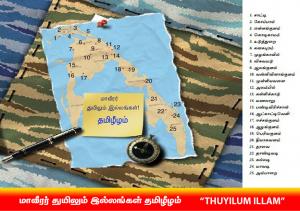The destruction of the cemeteries is cultural genocide, as it intentionally eliminates Tamil identities in Tamil Eelam.
— Tamil Genocide Memorial
TORONTO, ONTARIO, CANADA, April 10, 2023/EINPresswire.com/ — Tamil Genocide Memorial (TGM) released a statement: “TGM raised concern about the destruction of the Tamil Heroes Cemeteries at the recent UN General Assembly’s Universal Periodic Review stakeholder report in February 2023. The UPR stakeholder report (A/HRC/WG.6/42/LKA/3) Item 55 stated that “Tamil Genocide Memorial (TGM) expressed concern that the destruction of Tamil combatants cemeteries were intentional and planned actions by the Sri Lankan Government, noting that those cemeteries were resting places of over 40 thousand Tamil combatants, as remembrances of the dead.”
BELOW, PLEASE FIND THE FULL STATEMENT:
On November 27, 2022, thousands of Tamils gathered across Tamil Eelam (the Tamil homeland), to mark Maaveerar Naal or Great Heroes Day, and remember those who sacrificed their lives in the Tamil struggle for liberation. The Sri Lankan government destroyed 33 cemeteries which are located in Nothern and Southern parts of Tamil Eelam. The destruction of Tamil combatants’ cemeteries was an intentional and planned action by the Sri Lankan Government, noting that those cemeteries were resting places of over 40 thousand Tamil combatants. Many of these cemeteries consisted of revived ancient Tamil traditions where the fallen were remembered by planting tombstones called Nadukal. Although the cemeteries are destroyed, Tamils still bring the debris of tombstones in honor of the fallen Tamil heroes.
In Tamil Eelam, between 1989 and 2009, there were 27 Tamil heroes’ cemeteries. And an additional six cemeteries were built during the 2008-2009 genocidal war. Of the 33 cemeteries, many pictures and details still can be found in the digital space. The Tamil heroes’ cemeteries are part of Tamil identities.
In 2018, at the 2nd International Conference on Tamil Homeland and Genocide in Sri Lanka, Dr. Camilla Orjuela, Ph.D. mentioned that “The lack of possibilities in Sri Lanka to mourn and remember those who died in the struggle – both civilians and fighters – has made the Tamil diaspora countries a main space for remembrance”. Maaveerar Naal in November traditionally draws large numbers of Tamils in the diaspora and holds the position of the main event which brings people together to respect those who fought for the homeland. The fact that the LTTE cemeteries were demolished in Sri Lanka and that honoring LTTE fighters there was outlawed, made the commemorations in the diaspora particularly important.
Aalangulam, Weliyakulam, Thiyagavanam, and Upparu in the Trinco district. Tharavai, Thaandiyadi, and Vagarai Kandaladi in the Batticaloa district. Udumbamkulam in the Amparai district. Mulliyavalai, Visuwamadu, Aalamgulam, Kallikadu, Alambil, Manalaaru Punithapoomi, and Manalaru Uthayapeedam in Mullaitivu district. Vilankulam and Eechchankulam in the Vanni district. Aadkaaddiveli, Pandivirichan and Mullikkulam in the Mannar district, Kanakapuram, and Mulangaavil in the Killinochchi district. Uduththurai, Koppai, Kodikamam, Ellangulam, and Saaddi in the Jaffna district.
During the last phase of the war between Tamil Eelam and Sri Lanka, the following cemeteries were formed in the Mullaitivu district. Suthanthirapuram, Dharmapuram, Irannaippalai, Pachchaippulveli, Mullivaikkal East, Mullivaikkal West.
Improper decolonization of the island of Ceylon began in 1948 and is continued by Sri Lanka’s genocide against Tamils to the present day. The British merged the Island’s two sovereign peoples under one administration in 1833 for the purpose of administrative convenience. This was not considered for review during the decolonization process of 1948. This led to the unitary state of Ceylon, known as Sri Lanka today. Forcibly maintaining the unitary state after decolonization has led to the genocide of the Eelam Tamils. This fails to recognize Sri Lanka’s genocide and state terrorism which have been the reason for the continuous human rights violation and failures in accountability.
The Vaddukoddai Resolution in 1976 stated: “This Convention directs the Action Committee of the TAMIL UNITED LIBERATION FRONT to formulate a plan of action and launch without undue delay the struggle for winning the sovereignty and freedom of the Tamil Nation, And this Convention calls upon the Tamil Nation in general and the Tamil youth, in particular, to come forward to throw themselves fully into the sacred fight for freedom and to flinch not till the goal of a sovereign state of TAMIL EELAM is reached.”. The Tamil nation voted in a landslide for the Tamil United Liberation Front in the 1977 elections, thus voting to restore the sovereignty of the State of Tamil Eelam. The democratic mandate by the Tamil people enabled the Tamil youth to fight for freedom based on the right of self-determination. The same resolution was reassured by a referendum of over 200 thousand Tamil diaspora in 2010. The LTTE did not begin the demand that Eelam Tamils should have their own country, nor has that demand ended because the LTTE’s leaders were killed. The state of Tamil Eelam has the right to defend itself, even before recognition. As the representative of that state, the LTTE had the right to engage in self-defense against Sri Lanka’s aggression, just as Ukraine does against Russia today.
The LTTE accepted and applied the four Geneva Conventions, and Additional Protocols I and II to the Conventions, on February 24, 1988. The LTTE’s declaration gave it the status of the representative of a party to the armed conflict.
All people remember, honor, and mourn their fallen soldiers. The 11th of November is Remembrance Day for the countries of the British Commonwealth. The Cenotaph (meaning Empty Tomb) in London carries the simple inscription “The Glorious Dead” and it is here that a Remembrance service is held each year at 11 am on the Sunday nearest 11 November. For the people of Tamil Eelam and for Tamils living in many lands and across distant seas, the 27th of November is the day on which they remember, honor, and mourn those who have given their lives in the Tamil Eelam struggle for freedom from alien Sinhala rule. It is the day marked by the death of Shankar in 1982 – the
TGM
Tamil Genocide Memorial
+1 647-875-7354
email us here
Visit us on social media:
Facebook
Twitter
YouTube
Killinochchi Kanagapuram Tamil Great Heroes Day on May 18, 2022
![]()
Originally published at https://www.einpresswire.com/article/627111071/destruction-of-tamil-heroes-cemeteries-in-tamil-eelam-and-the-denial-of-the-right-to-remembrance




